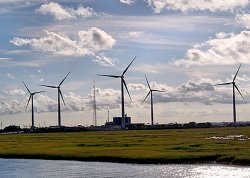Wind energy is a clean energy that is rapidly growing in coverage across the United States. Wind power harnesses naturally occurring winds to generate electricity. Because winds blow strongly in many areas regardless of conditions, wind turbines are capable of providing a consistent and renewable source of energy. Because these turbines operate on wind alone, wind energy is clean and carbon free, and can help offset emissions. The greatest value of wind energy is displacing fossil fuel electricity generation and the subsequent avoided emissions as they relate to climate change.
Learn about our research into offshore wind in Ocean City, NJ. Read the White Paper and results of our public survey!
How it Works
Wind turbines are mounted high in the air (generally over 100 feet), where they are buffeted by winds at their fastest and least turbulent. Wind that makes contact the propeller blades move the blades with a combination of lift and drag, similar in some ways to how airplanes attain flight. This movement turns a shaft within the base of the turbine, which creates electricity. Turbines are fairly consistent (they will generate energy around 90% of the time), and will turn with winds as weak as 6 to 9 miles per hour, but will generally shut down when winds reach dangerous speeds in order to avoid damaging equipment.
Wind Energy in New Jersey
Despite its great potential in the state, wind power has been slow to grow in New Jersey, and currently only a coastal wind farm in Atlantic City and a turbine in Bayonne represent the only active turbines in the state. These farms produce a relatively small 9 MW annually, representing only about .03% of electricity generation in the state, though the NREL estimates that this capacity could potentially be increased over a hundredfold to 945 MW. The future of wind in New Jersey will be offshore wine; limited available space and habitat conservation have influenced the lack of terrestrial wind energy. However, the high cost of energy transmission infrastructure and length application and review process challenge offshore wind energy adoption. While legislation has largely lagged, executive orders by Governor Murphy are poised to jump start wind energy throughout the state and along the coast with an aggressive goal of 3,500 MW of offshore wind power installed by 2030.
Learn more on the Department of Energy’s Wind Energy Technologies Office website.
